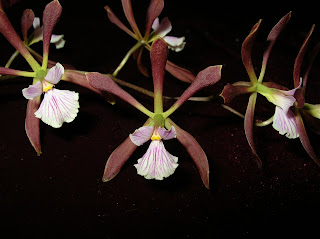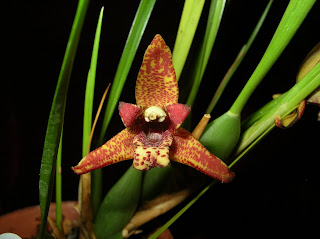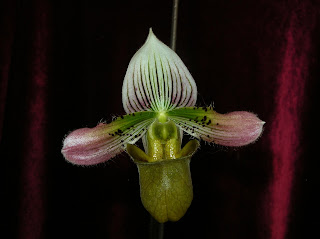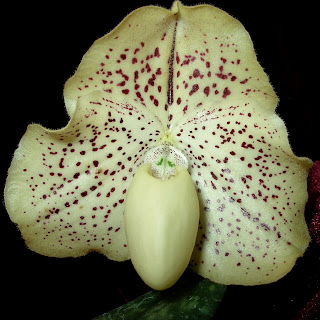Plant Sales Live on JuliaRedman.com

 Growing miniature orchids is a very worthwhile adventure. Not only are there so many to choose from, each with their own unique features, you can fit so many more into a small window. You can also sneak them in here and there around and on top of your larger plants if your space is getting slim. Today I'll showcase two cuties for which I have a couple plants available to share.
Growing miniature orchids is a very worthwhile adventure. Not only are there so many to choose from, each with their own unique features, you can fit so many more into a small window. You can also sneak them in here and there around and on top of your larger plants if your space is getting slim. Today I'll showcase two cuties for which I have a couple plants available to share.
The first is Neobathiea filicornu, an angraecoid species with a leaf span of around three inches topped by a cute white flower with a long nectary and nice large lip. This is a rarely seen species for all you angraecoid enthusiasts out there. I keep this plant in our cool to intermediate basement under fluorescent light year round. Blooming seems to coincide with humidity peaks (i.e. foggy windows) in our basement, but I don't know if such a humidity spike is required to induce blooming.
The second is Dendrobium rigidum, or at least that's how I know it. If you lookup rigidum online you'll find some other images. But these plants came to me as rigidum, and I have a friend who has been growing a few plants of this for several years also with the name rigidum. So we're sticking with rigidum for now. Anyway, the species has the neatest succulent foliage. Leaves are 1 to 4 inches tall, and very thick with a rough texture. These are adorned occasionally with slightly fragrant cream flowers with red markings. The plants are fairly easy to grow in an East or West facing window and make great mounted specimens.
 Recently someone came to me with a problem. Their orchid lost its buds soon after purchase, and hasn't bloomed or really done anything since. Since there are many many reasons for bud drop, we started discussing what might be happening. Fortunately, the owner sent me this photo of her plant. Immediately I could tell the plant has root rot, which is ultimately the cause for its listlessness.
Recently someone came to me with a problem. Their orchid lost its buds soon after purchase, and hasn't bloomed or really done anything since. Since there are many many reasons for bud drop, we started discussing what might be happening. Fortunately, the owner sent me this photo of her plant. Immediately I could tell the plant has root rot, which is ultimately the cause for its listlessness.
Photo provided by Tatyana.
Root rot is one of the most common diseases with orchids. Pretty much everyone has had to deal with it at some point or another. The most sad part is that new orchid growers, who are often not even at fault, mistakenly believe they "can't grow orchids" because they have simply purchased a hardware store plant that already has root rot without knowing. Today I am going to teach you how to diagnose, treat, and prevent root rot.
SYMPTOMS:
* Floppy, listless leaves. Although phalaenopsis leaves can be healthy and still bend or flop over in order to take the most advantage of the light, they should still be pretty tough and thick. These leaves, if touched, would feel withered and soft. Notice also the wrinkles on the leaf top-most in the photo. This plant has not been able to absorb enough water into its little body.
* Exposed roots, while healthy, are also withered and possibly brittle. Exposed roots are normal with phalaenopsis plants. However, they should be plump and active. (its OK to have some that are shutting down, since getting rid of old parts is normal for plants). This plant has been sacrificing water and sugars in the roots and other parts of the plant to live.
* Many to all in the media will be black and squishy - dead and rotting. This is the defining characteristic of the disease.
OTHER INDICATORS AND RISK FACTORS:
* Media appears to be a normal potting soil, which with a few exceptions is not really an appropriate potting mix for orchids. Exceptions include true terrestrial orchids (e.g. "jewel" orchids like Ludisia discolor), and people with experience using a media like this. There are some top growers who use a chunky coarse peat-based mix with great success, but for most people it stays too wet. It also requires regular repotting, since as it breaks down it will hold even more water. Staying wet too long leads to root rot, just like walking around with your feet wet might lead to foot fungus. Note also that this type of media has been popular with large nurseries growing plants for the "pot plant" trade, where plants are expected to be purchased just for the flowers and then tossed.
* In some cases, media may also just be a very degraded typical orchid mix. As noted above, rotting media starts to hold more and more water, increasing the risk for root rot if adjustments in the watering regeme are not made or the plant is not repotted.
TRIAGE AND TREATMENT:
* Pull the plant out of the pot immediately, removing all old media and dead roots. Dead roots will be squishy or papery and black. Leave any firm, healthy roots. Hose off plant.
* Cut or break away the base of the stem if it appears to be infected. Dust cut surfaces with cinnamon or sulfur.
* Optional: Spray plant with fungicide. > I generally do not do this for root rot as fixing potting problems are generally all that is needed to stop the spread of the problem.
* Leave to dry overnight.
* Optional: Soak entire plant in a warm solution containing a low concentration of sugar, a few drops of Superthrive (B vitimin / NAA coctail), and a low concentration of chemical fertilizer. > I have only tried this approach a few times. I cannot say if this actually confers an increase in survival rate, but am providing it for completeness.
* Repot plant into appropriate media. For rehabilitation of difficult cases I suggest using sphagnum moss, which has mild antibacterial properties. Prewet it and pack only loosely around the roots. Wetting any existing thoroughly will help them be more flexible. In this case, the only remaining roots were the surface roots. These were placed in the media so that they can better serve the plant during its recovery.
PROGNOSIS:
Plants with root rot can survive. Minor cases generally always survive. A case such as this will, not surprisingly, have a lower survival rate. Expect the more severe cases to take a year or more to recover fully.
PREVENTION:
* Repot your plants regularly to keep the media fresh. This will be approximately every 1-3 years depending on plant type, media type, and your watering habits. Repotting means removing old media and replacing with new. It does not always mean moving up in pot size. In some cases it can even mean a reduction in pot size.
* Know what is an appropriate watering regimen for your plant. This will depend on what type it is. If it is something unfamiliar to you, ask the grower you're getting it from. Also, hang on to your plant labels in case you have more questions down the road. Being able to tell other growers exactly what you have will make it easier for them to help you. Note that watering amount is not the issue. Watering frequency is. When it is time to water, water heavily and let it drain well. Letting a plant sit in water is generally not a good idea.
* If you buy from a non-orchid grower (such as from a perennial specialist) or hardware store, repot it immediately or as soon as possible. If it comes in "dirt", repot immediately even if the plant is in bloom. At the very least it is a good idea to pull a plant out of the pot and look at the roots and condition of the media when you get home with any plant.
DIFFERENTIAL:
* Watering too little can give the plant the same appearance. Definitive diagnosis here lies in the condition of the roots. Watering too little will of course not cause rot.
* High salt buildup can also cause a similar appearance, again minus the root rot. This essentially would be a dessication case. Salt buildup rarely reaches critical levels, however. You can identify it by a peculiar appearance of the media, including crusty deposits. This can generally be fixed by repotting, then prevented by watering occasionally with rainwater or RO water if fertilizer (or by fertilizing less!), or occasionally with Epsom salts (Magnesium Sulfate) solution if the cause is hard water.
ADDITIONAL INFORMATION:
Other helpful articles on this blog you may find helpful-
Basic Phalaenopsis Culture
Reasons for Plant Collapse in Phalaenopsis
How to repot a Paph Orchid

 Many orchids are fragrant, but a few really stand out. Right now on our back porch we have two that are absolutely yummy. The top photo shows Epidendrum (alatum x bractescens), also known as Encyclia (alata x bractescens), has a strong but very pleasing sweet rose-like fragrance most noticeable in our environment midday. Simply step out on the porch after lunch and inhale, and you'll smell the plant 4 feet away. Like most Encyclias, the plant has a high flower count and fat, round pseudobulbs.
Many orchids are fragrant, but a few really stand out. Right now on our back porch we have two that are absolutely yummy. The top photo shows Epidendrum (alatum x bractescens), also known as Encyclia (alata x bractescens), has a strong but very pleasing sweet rose-like fragrance most noticeable in our environment midday. Simply step out on the porch after lunch and inhale, and you'll smell the plant 4 feet away. Like most Encyclias, the plant has a high flower count and fat, round pseudobulbs.
The second photo shows Maxillaria tenufolia. This species always shows up whenever there is a fragrance class at a show or meeting, since it has an unmistakable and irresistibly yummy coconut fragrance. The plant likes medium to high light and is something of a climber, so is a great plant to grow mounted. You can also grow it to a nice specimen size in pots or just divide it every few years to share. I've recently divided up one plant and as soon as they seem happy in their new pots I'll be listing them on Etsy.
 The top photo shows Paph. acmodontum, a very nice species with bright coloring and a vigorous style. Foliage is green-on-green variegated with a lot of gloss.
The top photo shows Paph. acmodontum, a very nice species with bright coloring and a vigorous style. Foliage is green-on-green variegated with a lot of gloss. The second photo shows a selectively bred yellow Paphiopedilum from the brachypetalum section. This striking individual is Paph. (S. Gratrix 'Luna Amarillo' x Biplane 'Canary'). There are a few top notch breeders out there who are selecting for stronger color in brachypetalum hybrids, which all tend toward white. Al has a few seedlings of these breeding lines in his greenhouse and I just couldn't pass this one up. (There was another I snatched for me, but the flower was on the way out and I didn't photograph it.) This one has good size, its pretty flat, a clean pouch, pale sunshine yellow color. But the neatest feature is a little white spot on the top center of the dorsal sepal - its difficult to see in the photo. Hope it shows up again in future flowerings.
The second photo shows a selectively bred yellow Paphiopedilum from the brachypetalum section. This striking individual is Paph. (S. Gratrix 'Luna Amarillo' x Biplane 'Canary'). There are a few top notch breeders out there who are selecting for stronger color in brachypetalum hybrids, which all tend toward white. Al has a few seedlings of these breeding lines in his greenhouse and I just couldn't pass this one up. (There was another I snatched for me, but the flower was on the way out and I didn't photograph it.) This one has good size, its pretty flat, a clean pouch, pale sunshine yellow color. But the neatest feature is a little white spot on the top center of the dorsal sepal - its difficult to see in the photo. Hope it shows up again in future flowerings.
Hey fellow plant nerds.
We did the Clarksburg Farmer's market this past weekend. It was an enjoyable market - food, veggies, herbies, crafts, live music, and more. We'll be there again selling orchids on 7/12/09, 8/9/09, 9/20/09, 10/11/09, and 11/1/09. The market is there every Sunday, but events vary. I really liked the music, wish that more of our days co-insided with live bands. Maybe they'll schedule some more to fill in the gaps.
Anyway, while we had plenty of plants to be shopped, what we lacked was a tent. Not for lack of ordering one though... Without the generosity of Deb at AWEshop we and the plants would have fried! That's right, crispy, crispy critters. Deb saved the day by lending us her tent. THANK YOU DEB!!
Deb is primarily a jewelry designer, with some very nice work. She has a number of wire/metal work pieces that have a sleek and powerful, yet very feminine aire. I always admire the wire work because, having tried it, I know it is much harder than it looks. Overall style is organic, fluid, honest. Let me show you some of my favorites from her shop. Just click on the images for more information.


 To see more about Deb and her work, check out her Etsy shop and blog.
To see more about Deb and her work, check out her Etsy shop and blog.
